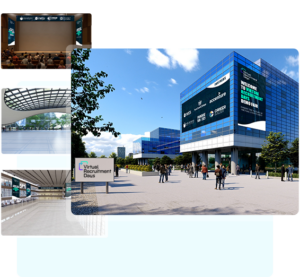The Corona Virus Pandemic in 2020, has led people to isolate themselves from each other due to its contagious nature. Businesses had to rethink their entire strategies and a growing trend is adopting a more #GOVirtual approach. They have since adopted the use of digital platforms such as Video / Voice Calling, webinars, virtual events and so on.
Through social distancing, we have seen a great improvement in the quality of air, overall cleanliness, and environmental noise. Another not-so-often observed factor by which the environment has thrived is through the inculcation of hosting virtual events as supposed to physical events routinely. The biggest environmental deterrent is the carbon footprint left behind, especially from physical events.
“Carbon footprint” Explained in the Context of Physical Events
Events put together by organizations contribute to the emission of greenhouse gases which are expressed as carbon dioxide equivalent. This is known as a carbon footprint. These gases are produced, directly and/or indirectly as a result of human activities. The level of carbon dioxide produced through these endeavours in association with organizations and their events are classified as leaving behind a carbon footprint.
Carbon emissions are caused by humans as carbon dioxide is released into the atmosphere from regular human activities such as traveling via aeroplanes, use of paper, plastic, food waste, and driving vehicles. According to The Environmental Protection Agency transportation, production of electricity, industry, agriculture, and commercial residue are the main sources of the production of greenhouse gases. Moreover, US Greenhouse Gas Emissions and Sinks reported in 2017, that 28.9% of greenhouse gas emissions are accumulated through the use of vehicles.
The Effects of Carbon Footprint on the Environment
The livelihood of the entire planet and everything living within it is threatened by carbon emissions, as they cause global warming. The melting of the polar ice caps, the rising sea levels, the disturbance of animal habits and extreme weather anomalies are all caused due to the onset of global warming. In its essence, carbon dioxide is a pollutant and when it is mixed with other particles in the air, it creates a harmful substance that is dangerous to all life when it reaches a concentrated level.
According to NASA, the polar ice caps have been melting at a rate of 9% per decade and now the thickness of the Arctic ice has decreased by 40%. 46% of the world’s trees have been cut down due to deforestation. 15,000 species of animals are threatened with extinction and 600 plant species have been lost from the wild. Not only are these emissions hazardous for the environment, but they also affect humans directly. Inhaling these gases in the form of smog or air pollution can lead to the onset of many respiratory and skin diseases. If these carbon emissions are not kept in check, they can wipe out animal species, and destroy crops and lands, which would end human life, as we know it.
Virtual Events and Carbon Footprint
Before the pandemic, businesses and organizations held big events that lead to the gathering of many people who traveled to specified locations using different modes of transportation. It is estimated that 1.8 million events are held per year in the UK alone. These emitted noxious amounts of carbon dioxide and contributed to over 50% of air pollution throughout the world. The onset of the pandemic led organizations to change their ways and shift onto online platforms to promote brands and services. The reduction in the overall use of vehicles and the reduction in industrial work have led to improvement in the environment. As the use of virtual events completely eradicates the need for travelling, carbon emissions have been reduced by 26% on average.
The Benefits of Virtual Events
When a large gathering of people takes place, a lot of garbage and waste is left in its wake. A study conducted in California found that the average participant at a public event generates 2.5 pounds of waste per day. Now, that corporations have shifted towards online mediums, this waste of food and natural resources has been eliminated. Papers were utilized on a huge scale to print out banners and pamphlets, which were produced by cutting down numerous trees. It is estimated that each year, 11.3 million metric tons of paper are used in the United Kingdom alone.
Overall, two billion trees are cut down to make paper for human consumption. As the need for paper is reduced, so does the need to cut down trees. More trees mean more oxygen production, they contribute towards bigger, healthier ecosystems. By hosting a virtual event, corporations can save 36000 sheets of paper from just one event.
Hosting virtual events helps save companies money by avoiding the environmental and financial costs of the events by 75%. Putting attendees in hotels, catering to their needs and the use of other resources, costs money and effects the environment. Furthermore, the overall wastage that is accumulated from hosting physical events is reduced as these things are not needed. Daily global carbon dioxide emissions decreased by 17% from just under half from changes in surface transport. At their peak, emissions in individual countries decreased by 26% on average.
Post-COVID-19 Events
Science has always helped man in his endeavours and this pandemic will not be an exception. Soon, the leading scientists of the world will make a vaccine and things will go back to normal. There are two paths that can be taken after that. One is returning to our former ways and causing further devastation in the environment or we can keep using beneficial online software, to continue helping the environment.
Virtual events have the ability to connect audiences and corporations through the use of online event platforms. Bringing hundreds of people together without wasting any resources are beneficial for the environment and for all the parties involved. It is the future of event management and should still be used after the pandemic is officially over. Corporations can achieve the same level of engagement and results from virtual events that they have been accumulating from physical events.
Hybrid Events after Covid-19
After the pandemic, if corporations still feel that their virtual practices are inadequate, opt for hybrid events. Hybrid events are one of the innovations of modern times, they enable the merging of both virtual and physical events. People attending these events experience the features of both of these events. Hybrid events have gained much popularity in the last year due to which a lot of corporations have inculcated them into their framework. Their ability to provide an optimal physical and virtual environment at the same time is what makes them so great. Even before the pandemic, 65% of companies throughout the world had started employing hybrid events.
Attendees have the option of visiting physical locations to attend the meetings or to attend them on a virtual event platform. This increases the reach of the corporation by 80% as aspiring individuals can join the event from any corner of the world. Thus, increasing the return on investments which leads towards greater exposure and higher profits. Lastly, they also help in the easy collection of analytical data gathered through these events that help corporations judge the success of their affairs.
The biggest advantage of holding hybrid events, especially after the pandemic is that it will help the environment by reducing the carbon footprint left behind by the emission of greenhouse gases. This in turn will help through the reduction of global warming and the overall degradation of the environment. If we cannot completely shift towards online platforms, we can at least try to go halfway and repair some of the damage that we have caused in the past.
Conclusion
Virtual events are the best way to inculcate an environmentally friendly aspect into events and conferences. This pandemic has forced businesses into going virtual, but it is a civic duty that must drive them to prevail on this path and continue working for the betterment of the environment. It is very important to keep in mind the environmental impacts of events. Specifically, those held on physical platforms. Recycling and reusing waste is the most environmentally friendly option. A healthier environment will lead to a better quality of life for all living things on the planet.
Author | Zoha Junaid






